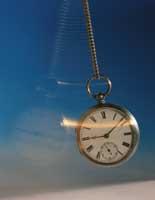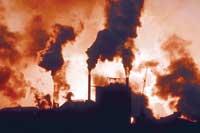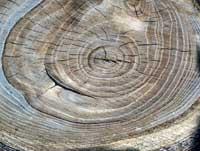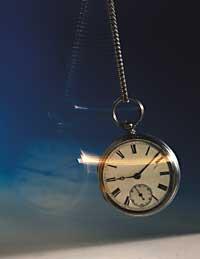Carbon 14 watch from the past
2008/01/06 Álvarez Busca, Lucía - Elhuyar Zientziaren Komunikazioa

Living beings continuously capture the carbon isotopes in the atmosphere: the plants through photosynthesis, and the animals feed the plants. Specifically, they absorb isotope 12, 13 and 14 carbon, why is carbon 14 used for this test and not 12 or 13?
The essence is found in the instability of the isotope. In fact, the isotopes of carbon 12 and 13 are stable, that is, they do not decay and their concentration does not vary over time. However, carbon 14 is unstable and is disintegrating with the passage of time.
By 1940 Willard Frank Libby discovered that the decay of Carbon 14 had a certain rhythm. It is estimated that at the 5,568 years of its disintegration half of the isotope concentration would remain. This is called the semidisintegration period of the atom.
From there, Libby developed a technique to know the time when the footprints of living beings are: the technique of carbon 14.
Loss of carbon
As carbon 14 decays, living beings capture more carbon and maintain levels of concentration. However, when they die they do not penetrate carbon and the 14 carbon atoms begin to disintegrate constantly. Known the rate of decay of Carbon 14, one can calculate the number of years elapsed since the death of the living being.
In particular, the years passed until 1950 can be calculated. In fact, XX. The nuclear tests carried out in the second half of the twentieth century modified the proportions of carbon in the atmosphere.
Carbon limits 14
This technique has other limitations. On the one hand, logically, it only serves for the dating of living beings, so it cannot be used to calculate the years of rocks, for example.

On the other hand, a maximum of 50,000 years can be retracted through carbon 14. The oldest traces that these should be studied by other techniques such as the study of radioactive isotopes with a longer life.
In addition, Libby made several mistakes when proposing the technique. According to the latest calculations, the period of carbon semidecay is not 5,568 years, but 5,730 years. In turn, it considered that carbon concentrations in the Earth's atmosphere have been historically similar, but it has not been.
For example, the modification of the Earth's magnetic field has altered the levels of atmospheric radioactivity and during the industrial revolution, the use of charcoal has modified the proportions of the atoms of the atmosphere.
Verification of data
Various techniques have calculated how throughout history the proportion of atoms in the atmosphere has been modified, which has allowed to correct the deviations that occur in the carbon 14 technique.

Therefore, despite the technique used, the results are compared with those obtained by other tests in all the dating processes, thus obtaining a verified data. For this purpose there are other dating systems such as dendrochronology (study of tree rings), study of Arctic ice, historical records...
However, it can be affirmed that the carbon 14 technique is quite accurate. Calculating a deviation of 100 years has a reliability of 68%. Extending the deviation to 200 years, reliability rises to 95% and is, according to experts, the most reliable method to date traces of antiquity from 50,000 to 400 years ago.
Published in 7k

Gai honi buruzko eduki gehiago
Elhuyarrek garatutako teknologia






